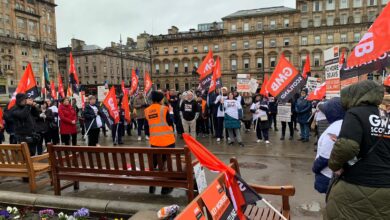Lessons of the Scottish teachers’ pay victory

By Jim Halfpenny, West Dunbartonshire EIS joint secretary (personal capacity)
Scottish teachers and their trade union, the EIS, have smashed through the pay cap of the employer, COSLA, and the Scottish Government, forcing them into offering an extra 4% on top of the inflation matching 9% three year deal already on the table. The 13.5% compound pay rise over three years is a significant achievement after years of pay austerity.
This victory was achieved on the back of a workforce which has had enough of declining pay in real terms (a 24% drop in the last ten years), unpaid hours, under resourcing of students with additional support needs and unsustainable workload. Many are leaving the profession as the education system nationwide gets to breaking point.
It was clear from overwhelming votes for rejection by teachers of the employers “final” offer of an extra 2%, then another “final” offer of an extra 3% that our members were not going to back down. 30,000 teachers on the streets of Glasgow last October exemplified this mood for action.
In the face of a ballot for strike action by the EIS, COSLA and the Scottish Government caved in with another “final” offer of an extra 4% which our members have accepted as the first stage of a continuing restorative pay campaign.
In real terms, with inflation running at around 3%, this deal is worth less than one and a half percent a year over three years. The intention of the EIS is to continue the fight for the return of the pay stolen from us since 2008 by the vicious programme of Tory austerity and we look forward to continuing this anti-cuts campaign with the other local authority unions.
Based on a common experience, the unity of the EIS classroom teachers was outstanding.
Overwhelmingly, a workforce of young women who, we were told, would never consider strike action, took to the fight with passion and determination.
In a totally instinctive response to exploitation by their employers they turned to the organised strength of the trade union movement, forcing the hand of a previously dormant leadership who had often sold them out on pay and conditions.
The change was rapid within the EIS as the old right wing guard was cast aside. Their pleas of “caution” at EIS conference now exposing them as the collaborators they were.
This victory, of course, must be seen in relative terms of what could have been achieved. Without any form of industrial action or even a vote for industrial action the campaign achieved a significant breakthrough. If a strike ballot and action had been pursued more rapidly even more could have been won.
Unfortunately, a significant minority on the National Council of the EIS called for acceptance of the extra 3% offer claiming that we would not be offered more. This position proved to be wrong as members were balloted and rejected the 3%. The Scottish Government came back with an increased offer.
On the back of this new offer a ballot for industrial action was cancelled at the last minute. There was concern voiced at the National Council that such a ballot would not overcome Tory anti-trade union thresholds and a recommendation for acceptance of the 4% was put to members.
On a turnout of 74% of the membership, 98% voted to accept. This startling result is a clear commitment by teachers to the leadership of the EIS. It is also clear that if they had called for rejection of the 4% and a move towards industrial action teachers would have overwhelmingly supported that position.
Ultimately a victory…but with greater confidence in the determination of classroom teachers throughout the country the opportunity of further gains was and is there to be grasped.



